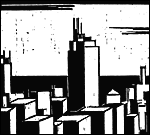William H. Whyte, City: Rediscovering the Center (Doubleday, 1988) Reissued by Anchor in paperback in 1990. City: Rediscovering the Center is the result of 16 years of meticulous study of pedestrian behavior in public spaces. Urban thinker William H. Whyte explores the city from a myriad of different angles, discussing topics ranging from patterns of pedestrian behavior, to the role of street corners, to the relations between buildings and the street, to the ascent of self-contained mega-structures like shopping malls. The cornerstone of Whyte's study is observation. Whyte had spent countless hours in the streets, watching and filming people, as well as charting their movements. Black and white photographs, as well as diagrams accompany the text. A strong advocate of busy, bustling streets, with business and social life spilling onto the sidewalk, Whyte argues that in order to thrive, cities need more congestion, not less. Written with wit and humor, City provides a multifaceted look at the practical implications of urban design without ever resorting to dry, solely factual information. Clearly, for Whyte, cities are above all about the people. He relishes the peculiarities of pedestrian behavior, describing at length such rituals as "the false goodbye" – where it takes two people several attempts before they finally take leave of one another – or the tendency of people to hold conversations right in the middle of the sidewalk, where pedestrian traffic is heaviest. Whyte devotes several chapters of the book to a more technical treatment of urban spaces, discussing, for instance, the impact of light and shadow on public spaces and the factors that influence the carrying capacity of buildings and plazas. But as Whyte points out in his opening chapter, "what is most fascinating about the street are the interchanges between people that take place in it." Even in his technical discussions, Whyte never loses sight of the ultimate purpose of urban planning: to enable natural interaction among city dwellers within the unnatural landscape of the city. Throughout the book, Whyte mourns the rise of what he calls "self-contained mega-structures," sprawling buildings with their own environments, completely separate from the street. The blank, unused spaces that result in-between and within such buildings are for Whyte the epitome of poor urban planning. "The key to the success or failure of an internal public space is its relationship to the street," he writes, adding that, "almost without exception the best-used and best-liked inside spaces in this country have a strong visual tie with the outside." Whyte, who died in 1999, started his career as an analyst and went on to become a planning consultant for various cities, as well as a distinguished professor at Hunter College. He is best known for his first work The Organization Man, which became a bestseller in 1956. City was also well received when it was first published in 1988. Many reviewers extolled the book's remarkable accessibility. "[Whyte's] observations and recommendations can be read with profit and pleasure by professional planners and readers interested in what makes a city tick," wrote Diane K. Harvey of Johns Hopkins University in Library Journal. Whyte's City, in other words, is consistently engaging and is bound to appeal to a very wide spectrum of people. MORE: New York Times' Obituary Links to reviews and articles about Whyte UC Berkeley's Research Guide to Urban Planning |
 |
|||||||||||||||||||||||||||